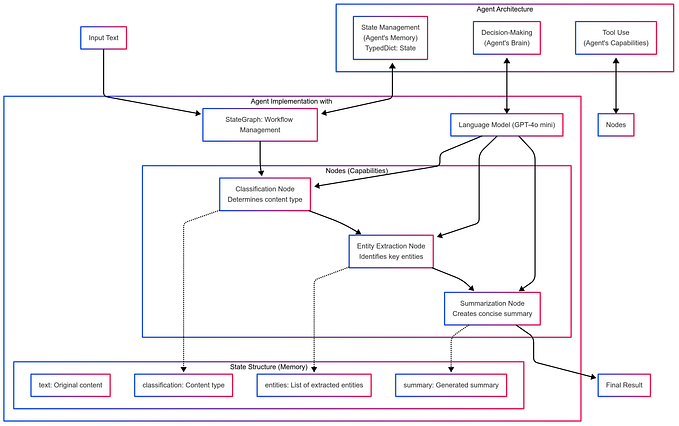
Are you eager to harness the potential of APIs in your Python programming? Your search ends here! In this article, we’ll delve into all the essentials you require to utilize APIs in Python. From grasping the fundamentals of APIs to mastering sophisticated methods for interacting with them, we’ll equip you with the expertise and capabilities needed to seamlessly incorporate APIs into your endeavors. Whether you’re an experienced coder or a beginner, this guide will elevate your API integration skills.
What is an API?
An API, or Application Programming Interface, is like a digital connector that allows different software programs to talk to each other and share information. It’s the technology behind how apps and systems communicate and work together smoothly. For example, think of APIs as the wiring that connects your smart home devices, enabling them to interact and perform tasks based on your commands.
API integration services are essential in today’s digital world because they simplify complex processes by providing a standardized way for software components to interact. This simplification increases efficiency, productivity, and innovation in software development. Businesses often use API integration services to connect internal systems, share data securely with partners, and create seamless customer experiences.
In essence, APIs and API integration services are the backbone of modern software development, enabling interconnected ecosystems that drive technological advancement and improve user experiences.
What Are the Importance of APIs?
APIs play a crucial role in modern technology and software development for several reasons:
Integration and Interoperability:
APIs allow different software systems and applications to communicate and work together seamlessly. This integration capability is essential for creating complex digital ecosystems where multiple services collaborate to deliver a unified experience. For example, APIs enable your social media accounts to connect with third-party apps, allowing you to share content across platforms effortlessly.
Efficiency and Productivity:
APIs save developers time and effort by providing pre-built functionalities and services. Instead of reinventing the wheel for every feature, developers can leverage APIs to access ready-made tools and focus on building unique functionalities. This efficiency leads to faster development cycles and quicker time to market for products and services.
Scalability and Flexibility:
APIs empower businesses to scale their operations and adapt to changing demands efficiently. Whether handling increased user traffic or integrating new features, APIs enable organizations to expand their capabilities without significant infrastructure changes. This scalability ensures that systems can grow alongside business needs without compromising performance.
Innovation and Collaboration:
APIs foster innovation by enabling developers to build upon existing technologies and services. Through API marketplaces and developer communities, companies can collaborate with external developers, encouraging the creation of innovative solutions and expanding the reach of their platforms. This collaborative ecosystem fuels creativity and continuously improves digital products and services.
Enhanced User Experience:
APIs provide a seamless and cohesive user experience by enabling data and functionalities to flow across different applications and devices. For example, e-commerce platforms use APIs to integrate payment gateways, shipping services, and customer support, providing customers with a smooth and integrated shopping experience.
What Makes Python a Preferred Choice for APIs?
Python stands out as a preferred choice for creating APIs due to several key reasons:
Simplicity and Readability:
Python’s clean and easy-to-understand syntax makes it simple for developers to create and maintain APIs. Its readability reduces the learning curve, allowing developers to focus more on building robust functionalities rather than wrestling with complex code.
Versatility:
Python’s versatility enables it to be used across various platforms and environments, making it an ideal language for developing APIs that run on different systems. This flexibility is crucial for creating APIs that cater to diverse user needs and integrate seamlessly with existing technologies.
Rich Ecosystem:
Python boasts a vast ecosystem of libraries and frameworks that simplify API development. Frameworks like Flask and Django provide robust tools for building RESTful APIs, while libraries such as requests facilitate seamless communication with external APIs.
Scalability:
Python’s scalability allows APIs to handle increasing loads and user requests without compromising performance, whether a small-scale application or a large-scale enterprise system; Python’s scalability ensures that APIs can grow alongside business requirements.
Community Support:
Python has a thriving community of developers actively contribute to its growth and development. This community support translates into extensive documentation, helpful resources, and knowledge developers can leverage when creating APIs.
Integration Capabilities:
Python’s integration capabilities make connecting APIs with databases, web services, and other third-party tools easy. This seamless integration streamlines data flow and enhances APIs’ overall functionality.
How to Use an API in Python: Step-by-Step Guide
Using an API in Python involves steps that allow you to interact with external services and retrieve or manipulate data. Here’s a detailed guide on how to use an API in Python:
Choose an API:
When delving into the realm of using APIs in Python for web development solutions, selecting the right API is paramount. Begin by identifying the specific functionalities or data your project requires, such as integrating payment gateways, accessing weather data, or incorporating social media features. Consider APIs that align with these needs and offer comprehensive documentation, clear endpoints, and support for Python integration. Assess factors like authentication methods, data formats, and rate limits to ensure seamless integration and optimal performance. By choosing an API that suits your project goals and technical capabilities, you lay a solid foundation for building efficient and innovative Python web development solutions, enhancing user experiences, and unlocking the full potential of API-driven applications.
Read the Documentation:
When using an API in Python, reading the documentation is crucial. Start by familiarizing yourself with the API’s endpoints, like specialized URLs for different functions the API can perform. Understand the request parameters required for each endpoint, such as query parameters for filtering data or authentication tokens for secure access. Pay attention to the response formats the API supports, like JSON or XML, as this determines how you’ll parse and use the data in your Python code. The documentation also outlines any rate limits, error codes, or best practices to follow. By thoroughly reading and understanding the API documentation, you’ll be well-equipped to effectively integrate the API into your Python projects and leverage its full capabilities.
Install Necessary Libraries:
Before using an API in Python, installing the necessary libraries that facilitate communication with the API is essential. One shared library requests, simplifying making HTTP requests to API endpoints and handling responses. Depending on the API, you may also need additional libraries or SDKs provided by the API provider. These libraries streamline tasks like authentication, data parsing, and error handling, making interacting with the API programmatically easier. To install a library-like request, you can use Python’s package manager pip by running a command like pip install requests in your terminal or command prompt. Once the required libraries are installed, you can begin coding to efficiently access and utilize the API’s functionalities within your Python projects.
Get API Credentials:
Obtaining API credentials is crucial for accessing protected endpoints and ensuring your requests are authorized when using an API in Python. API credentials, such as API keys, OAuth tokens, or usernames/passwords, act as a form of identification that verifies your identity and permissions to use the API. The API provider typically provides these credentials when you sign up for an account or register your application. Once you have your API credentials, store them securely and never share them publicly to prevent unauthorized access. In your Python code, include the credentials in your API requests to authenticate and gain access to the API’s functionalities, allowing you to retrieve data and perform actions as permitted by your credentials.
Make API Requests:
After understanding an API’s endpoints and obtaining the necessary credentials, making API requests in Python becomes the next step. Utilizing libraries like requests, you can send HTTP requests to the API’s designated endpoints, specifying the desired functionality, such as retrieving data or performing actions. These requests typically involve specifying parameters, such as query parameters for filtering data or authentication details for secure access. For example, when querying a weather API for current weather data in a specific location, you’d construct a GET request with the appropriate endpoint and parameters. Once the request is sent, the API processes it. It returns a response containing the requested data, which your Python code can then parse and utilize for further processing or display, enabling seamless integration of API functionalities into your projects.
Handle API Responses:
Handling API responses in Python is essential to effectively utilising an API. Once you send a request to an API endpoint, the API responds with data in a specific format, such as JSON or XML. You can use libraries like requests to receive and parse these responses in Python. After receiving the API response, your code should check the response status code to ensure the request was successful (typically a status code of 200). Next, extract the relevant data from the response based on your API query. For example, if you’re querying a weather API for temperature data, extract the temperature information from the response JSON. Properly handling API responses ensures that your Python application can interpret and use the data returned by the API accurately, enhancing the functionality and usability of your code.
Implement Error Handling:
Implementing error handling is crucial when using an API in Python to ensure your application responds gracefully to unexpected situations. Errors can occur for various reasons, such as network issues, invalid input, or server problems. In Python, you can use try-except blocks to catch and handle exceptions that may arise during API interactions. For example, you can see connection or HTTP errors to provide informative error messages to users or log detailed error information for debugging purposes. Additionally, consider implementing retry mechanisms for transient errors and incorporating rate-limiting logic to avoid exceeding API usage limits. Effective error handling helps your Python application maintain robustness, reliability, and user-friendly behaviour, enhancing the user experience.
Test and Iterate:
Testing and iteration are critical phases when using an API in Python to ensure your code functions as expected and meets project requirements. Test your API integration with different scenarios, inputs, and edge cases to validate its functionality and reliability. Verify that API requests return the correct responses and handle potential errors gracefully. Use testing frameworks or manual testing methods to thoroughly examine your Python code’s behaviour when interacting with the API.
After testing, iterate on your code as needed to address any issues, optimize performance, or add new functionalities. Incorporate feedback from testing to make improvements, enhance error handling, and optimize API request strategies. Continuous testing and iteration help refine your Python application’s API integration, resulting in a robust, efficient, and user-friendly implementation that meets user expectations and project objectives.
Conclusion
In wrapping up this beginner’s guide on using APIs in Python, it’s clear that mastering API integration opens doors to robust software development solutions. Beginners can confidently navigate API integration by understanding how to choose the proper API, reading documentation thoroughly, installing necessary libraries, acquiring API credentials securely, making effective API requests, implementing error handling, and rigorously testing code. These skills empower developers to create innovative solutions, seamlessly integrate external services, and enhance software development projects. As you embark on your journey of using APIs in Python, remember that continuous learning, practice, and exploration are key to leveraging APIs effectively and building impactful software solutions.









